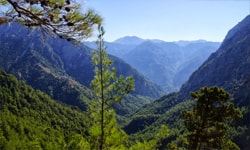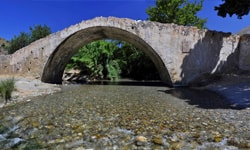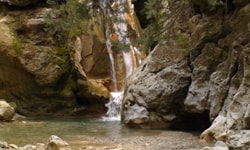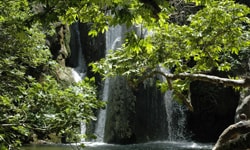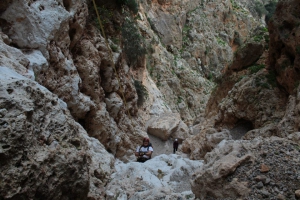At the furthest tip of Akrotiri Cape there is the gorge of Diplochachalo. It is located close to the village of Chordaki, on the way to the famous beach of Stefanou. This is a small, stunning and purely technical canyon with 6 descents, 2 of which are quite high. It starts just below the quarry that dominates the area.
The gorge of Adrianos starts from the village Adrianos. In some places there are high rocks that impede the free course through the canyon, making walking difficult, but not impossible (the course needs about 3 hours). The river flowing in its bed is Skoulikaris that starts near village Potami and it empties in the town of Agios Nikolaos.
Spiliotissa gorge is located about 24km south of Heraklion. It is a lush ravine that runs from the village Houdetsi, crosses Agios Vasilios, and ends in the valley of Peza. The best part of it is that between Houdetsi and Agios Vasilios (1.5km long).
One of the many parallel canyons of the wider area of Fragokastelo. It is a small canyon (2km long) starting from the beautiful plateau Manikas and ending at the seaside village Skaloti after 1:30 hours hiking with steep slopes.
Achendrias gorge is located about 52km south of Heraklion, is approximately 8km long and ends on the beach Maridaki. It crosses the arid landscape of Asterousia Range that is characterized by bare mountains, sharp rocks and rough pasture lands. Throughout most of its length it is easily accessible and is dry in summer.
The gorge of Agia Irini by Ziros is actually a set of two parallel canyons that merge shortly before the sea, at the point where the dirt road passes to the beach of Agia Irini. Both canyons are very wild, rocky, with steep slopes and high walls. Especially the westernmost of the two branches is quite eerie and dangerous for those who have no experience of hiking in canyons (still it is not technical).
The gorge of Xerokambos – Ziros, officially called “Lamnoni gorge”, is the driest canyon of eastern Crete. Walking in the gorge takes approximately 2 hours and the descent is quite easy and smooth. The canyon has typical wild cretan beauty, with bare, tall walls and undergrowth. Throughout the journey, you'll admire the view to the blue Libyan Sea.
The gorge of Eligas is a monument of natural beauty located on the west side of the mountain Koupa near the village Miliaradon by Embaros. It is actually a high waterfall with nine rapels, ideal for canyoning. The difference of altitude between the entrance and the exit is about 230m.






